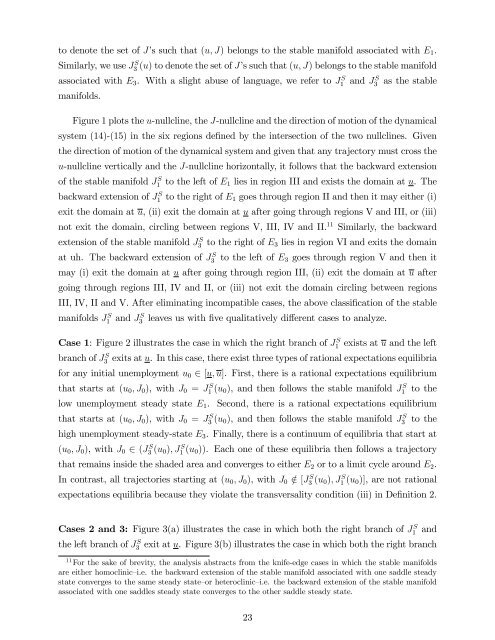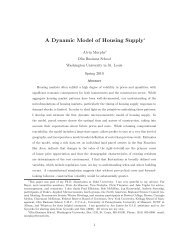Shopping Externalities and Self Fulfilling Unemployment Fluctuations*
Shopping Externalities and Self Fulfilling Unemployment Fluctuations*
Shopping Externalities and Self Fulfilling Unemployment Fluctuations*
Create successful ePaper yourself
Turn your PDF publications into a flip-book with our unique Google optimized e-Paper software.
to denote the set of J’s such that (u; J) belongs to the stable manifold associated with E 1 .Similarly, we use J3 S (u) to denote the set of J’s such that (u; J) belongs to the stable manifoldassociated with E 3 . With a slight abuse of language, we refer to J1 S <strong>and</strong> J3 S as the stablemanifolds.Figure 1 plots the u-nullcline, the J-nullcline <strong>and</strong> the direction of motion of the dynamicalsystem (14)-(15) in the six regions de…ned by the intersection of the two nullclines. Giventhe direction of motion of the dynamical system <strong>and</strong> given that any trajectory must cross theu-nullcline vertically <strong>and</strong> the J-nullcline horizontally, it follows that the backward extensionof the stable manifold J1S to the left of E 1 lies in region III <strong>and</strong> exists the domain at u. Thebackward extension of J1S to the right of E 1 goes through region II <strong>and</strong> then it may either (i)exit the domain at u, (ii) exit the domain at u after going through regions V <strong>and</strong> III, or (iii)not exit the domain, circling between regions V, III, IV <strong>and</strong> II. 11 Similarly, the backwardextension of the stable manifold J3S to the right of E 3 lies in region VI <strong>and</strong> exits the domainat uh. The backward extension of J3S to the left of E 3 goes through region V <strong>and</strong> then itmay (i) exit the domain at u after going through region III, (ii) exit the domain at u aftergoing through regions III, IV <strong>and</strong> II, or (iii) not exit the domain circling between regionsIII, IV, II <strong>and</strong> V. After eliminating incompatible cases, the above classi…cation of the stablemanifolds J1 S <strong>and</strong> J3 S leaves us with …ve qualitatively di¤erent cases to analyze.Case 1: Figure 2 illustrates the case in which the right branch of J1S exists at u <strong>and</strong> the leftbranch of J3 S exits at u. In this case, there exist three types of rational expectations equilibriafor any initial unemployment u 0 2 [u; u]. First, there is a rational expectations equilibriumthat starts at (u 0 ; J 0 ), with J 0 = J1 S (u 0 ), <strong>and</strong> then follows the stable manifold J1S to thelow unemployment steady state E 1 . Second, there is a rational expectations equilibriumthat starts at (u 0 ; J 0 ), with J 0 = J3 S (u 0 ), <strong>and</strong> then follows the stable manifold J3S to thehigh unemployment steady-state E 3 . Finally, there is a continuum of equilibria that start at(u 0 ; J 0 ), with J 0 2 (J3 S (u 0 ); J1 S (u 0 )). Each one of these equilibria then follows a trajectorythat remains inside the shaded area <strong>and</strong> converges to either E 2 or to a limit cycle around E 2 .In contrast, all trajectories starting at (u 0 ; J 0 ), with J 0 =2 [J3 S (u 0 ); J1 S (u 0 )], are not rationalexpectations equilibria because they violate the transversality condition (iii) in De…nition 2.Cases 2 <strong>and</strong> 3: Figure 3(a) illustrates the case in which both the right branch of J1S <strong>and</strong>the left branch of J3S exit at u. Figure 3(b) illustrates the case in which both the right branch11 For the sake of brevity, the analysis abstracts from the knife-edge cases in which the stable manifoldsare either homoclinic–i.e. the backward extension of the stable manifold associated with one saddle steadystate converges to the same steady state–or heteroclinic–i.e. the backward extension of the stable manifoldassociated with one saddles steady state converges to the other saddle steady state.23
















